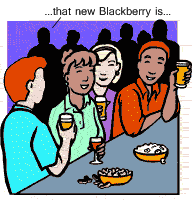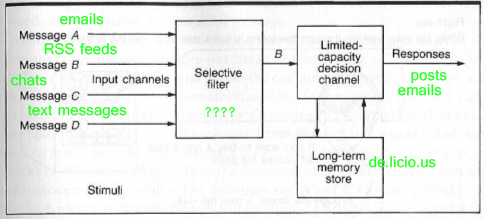 You’re at a crowded holiday cocktail party and engaged in conversation about politics. Oh, first a little backstory: For the last week you’ve been thinking of buying the new Blackberry phone. Back at the party, you suddenly realize that the people behind you are talking about Blackberries. Involuntarily, your attention shifts to that conversation.
You’re at a crowded holiday cocktail party and engaged in conversation about politics. Oh, first a little backstory: For the last week you’ve been thinking of buying the new Blackberry phone. Back at the party, you suddenly realize that the people behind you are talking about Blackberries. Involuntarily, your attention shifts to that conversation.
What does this have to do with the web? It’s the problem of information overload again. Before your attention shifted, you were able to concentrate on your conversation even though your ears were recieving input from all the other conversations. This magic is known as the cocktail party effect. Most scientists focus their research on how this is possible, but I’m more fascinated by the shifts in attention that comes when something “interesting” is said in a non-attended conversation. This is a great example of your brain manages limited attention resources.
Two immediate corrolarys to the web:
- You read a limited number of blogs, visit a limited number of sites. You’d like to know if something was being “said” about things you find interesting, even if doesn’t happen on the stuff you normallly pay attention to. Google search alerts and Technorati/Delicious tag searches serve this purpose to some degree, but thier usefulness is limited by the fact that they pay attention to all conversations. It’s as if you at the cocktatil party could hear conversations about Blackberries happening all around the world. The party itself at its selection of people acts as a filter too. In the same way, I believe your social network should act as a filter to what sources are considered by any intelligence amplifying algorithms.
- Second, this effect is part of the success of Google AdWords. You are primarily paying attention to the organic search results on the left, but an ad on the right with the right phrase might catch your attention.
There is good research and some theries about these areas from the brain side. Given my cognitive scientist background, it’s fascinating to re-read this material from a Web 2.0 and Attention Economy point of view. If you’re also interested, this slideshow gives a nice overview.
I’ll leave you with Broadbent’s “Filter Theory of Selective Attention”. (The most basic model proposed for how the Cocktail Effect is accomplished in the brain.)

…could be re-imagined as:
